





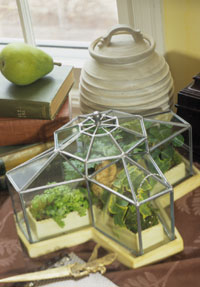 The artillery plant, fern, and ivyhave been planted directly in thismini conservatory's tray.
The artillery plant, fern, and ivyhave been planted directly in thismini conservatory's tray.
1. To plant directly in the conservatory, choose small plants, those in 2- and 3-inch pots. Go for a combination of taller plants and sprawling plants as well as a mix of foliage colors and shapes.
2. If the plant is a little too large for the conservatory, you can divide it -- tear off a portion and plant it.
3. If you need to add soil, any good-quality all-purpose potting soil will do. If soil shows in the finished planting, tuck in bits of green florist's moss on top of the soil to cover and to add effect.
4. Trim off any foliage that would touch the glass, fostering bacterial growth and contaminating everything. Then add stones, little sculptures, acorns, dried leaves, twigs, and other natural elements for decorative touches.
Find the perfect plants for your terrarium.
Learn how to make a fairy garden in a terrarium.
continue reading below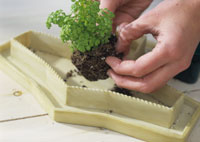 Small plants will probably needthe bottom of their root ballknocked off.
Small plants will probably needthe bottom of their root ballknocked off.
To discover which plants flourish in the humidity, download our free Humidity-Loving Plants chart. (Downloading requires Adobe Acrobat.)
Download Humidity-Loving Plants chart.
Give any room in your home an herbal makeover without the mess that houseplants can make. These six terrariums -- from aquatic to desert, formal to whimsical -- will inspire you to bring the best of nature to your table.
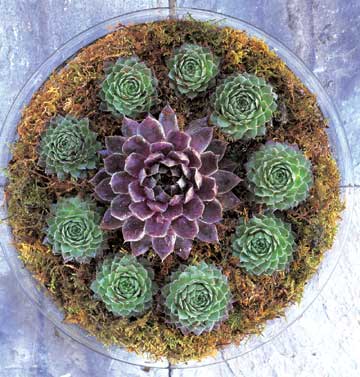 This miniature garden grabs
lots of attention.
This miniature garden grabs
lots of attention.
Combine a dozen or so hens-and-chicks (Sempervivum) in a standard pie dish padded with spaghnum moss to create a graphic botanical dial.
Succulents are shallow rooted and well suited for flat container gardens, which would normally require more regular watering. But these plants are desert natives that store water in their thick leaves. Keep plants warm, dry, and draft free.
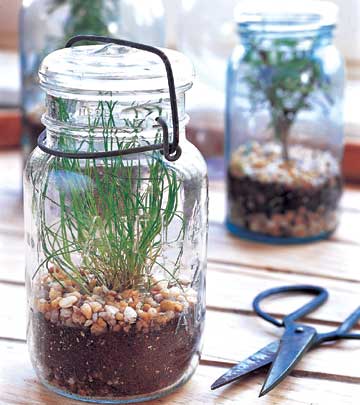
Vintage mason jars are the ideal containers for a kitchen herbarium. They're inexpensive and attractive, especially on a sunny windowsill, and will provide you with a year's supply of fresh seasonings.
Almost any herb can be started from seed in a mason jar. Chive, thyme, and rosemary are excellent choices. For each, follow package instructions and keep soil warm, moist, and in full light until seeds have germinated. When they outgrow their space, you can cut them as needed, or transplant them into a larger container or into the garden.
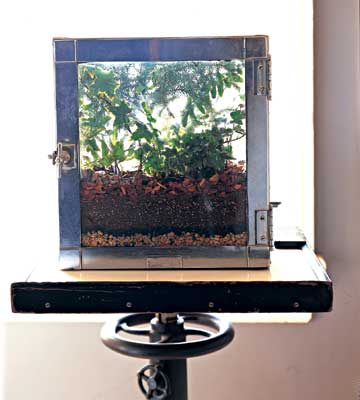
Create a sense of shrouded woodland mystery by enclosing plants -- Boston ferns, variegated ivy (Hedera spp.), Norfolk Island pines -- in a vintage nickel barber case.
Start with three planting mediums common to most terrariums, then top with a layer of cedar mulch.
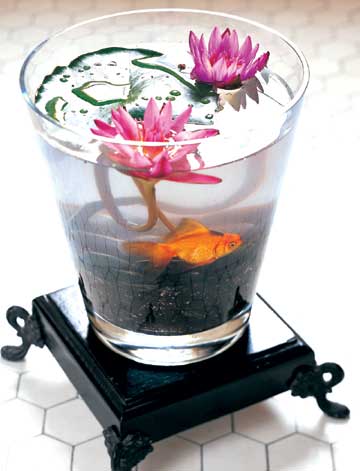 Add some exotic to a regular
fishbowl with a water-lily.
Add some exotic to a regular
fishbowl with a water-lily.
Recreate a garden pond in a terrarium with waterlilies, warm water (maintained at 70 degrees F), and plenty of sun to thrive. Dispense of the dirt on the root ball and anchor the plants with decorative stones. In a week or so, when the blooms are gone, move the lilies to an outdoor pond.
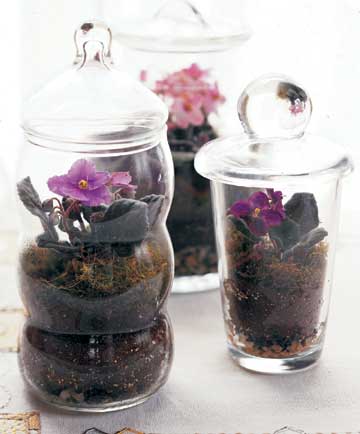 Spotlight your favorite flowers
in this setting.
Spotlight your favorite flowers
in this setting.
While most terrariums don't have flowers, some plants can put on quite a show. Miniature African violets (Saintpaulia) are a perfect example. When placed in small containers, such as apothecary jars and drinking glasses with mix-and-match lids, violets' dainty size and bright velvety colors make them glow like jewels under glass.
Plant violets by placing a single rooted cutting in the moist terrarium soil. Leave the lid on and place the jar out of direct sunlight.
Before long, violet cuttings will establish themselves and grow into healthy plants, which should be transplanted before the leaves touch the sides of the container.
Test Garden Tip: A good way to water all terrariums is with a bulbous turkey baster, letting water flow down the inside of the container's glass walls so as not to disturb the soil or the plant.
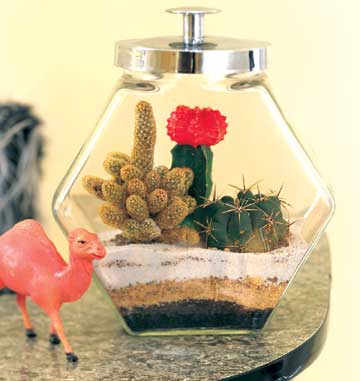
Cactus terrariums are foolproof for unskilled gardeners.
Materials:
-Basic cactus medley
-Sand
-Hexagonal candy jar
Cacti require lots of direct sunlight. And the soil/sand should be fairly dry, but not bone dry. If you overwater, condensation will appear on the glass. Remove the lid so that any extra moisture can escape.
Planting the cacti is the biggest challenge. We suggest pasta tongs or tongue depressors.
A good way to water all terrariums is with a bulbous turkey baster, letting water flow down the inside of the container's glass walls so as not to disturb the soil or the plant.
Copyright © www.100flowers.win Botanic Garden All Rights Reserved